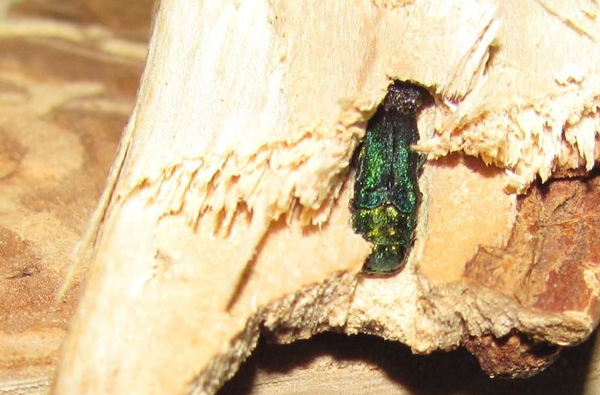Emerald Ash Borer: Worst Forest Pest Ever
By Chris Williams on January 23, 2014.

You may not know this but ash trees (Fraxinus sp.) are in serious trouble throughout much of the US and in parts of Canada because of yet another imported insect pest from Asia. The culprit is a small, (about 1/2inch long) brilliant metallic green beetle (Agrilus planipennis), which lays its eggs between the layers of bark or in bark crevices during the late spring. Larvae hatch within a week and begin damaging bark tissue and phloem tissue with their feeding activities.
It is the tree’s phloem that is responsible for transporting nutrients up into the tree’s canopy, and infested trees will show dieback in the upper crown, and may exhibit damage from woodpeckers that dig out and feed on the larvae. A heavily infested tree with a thinning canopy will often respond by developing epicormic branching on its trunk. Emerald ash borer completes its’ feeding by fall but remains in a ‘pre-adult’ state through the winter with adult beetles emerging in mid to late spring.
Why Is the Emerald Ash Borer the Worst Forest Pest?
How has the Emerald ash borer earned the distinction of being the worst forest pest ever? From the time since EAB’s initial discovery in Michigan in 2002 and it’s subsequent spread to most of the eastern half of the US, Ontario and Quebec it is estimated to have killed tens of millions of trees. Economic impact could reach into the billions of dollars if the beetle is not stopped.
Regulatory measures like quarantines and educational programs are in place now to alert the public as to the consequences of spreading this insect around (hefty fines) and ways to prevent its movement. Even though the beetle is a pretty strong flier, it turns out that most of its spread has been attributed to transportation in infested firewood, logs, and nursery stock.
Further Reading
The following references were used to bring you this information.
- http://www.emeraldashborer.info/index.cfm#sthash.zeeQNI8b.dpbs
- http://stopthebeetle.info/quick-facts-about-the-eab/
Photo credit: USFS Region 5 / Foter.com / CC BY